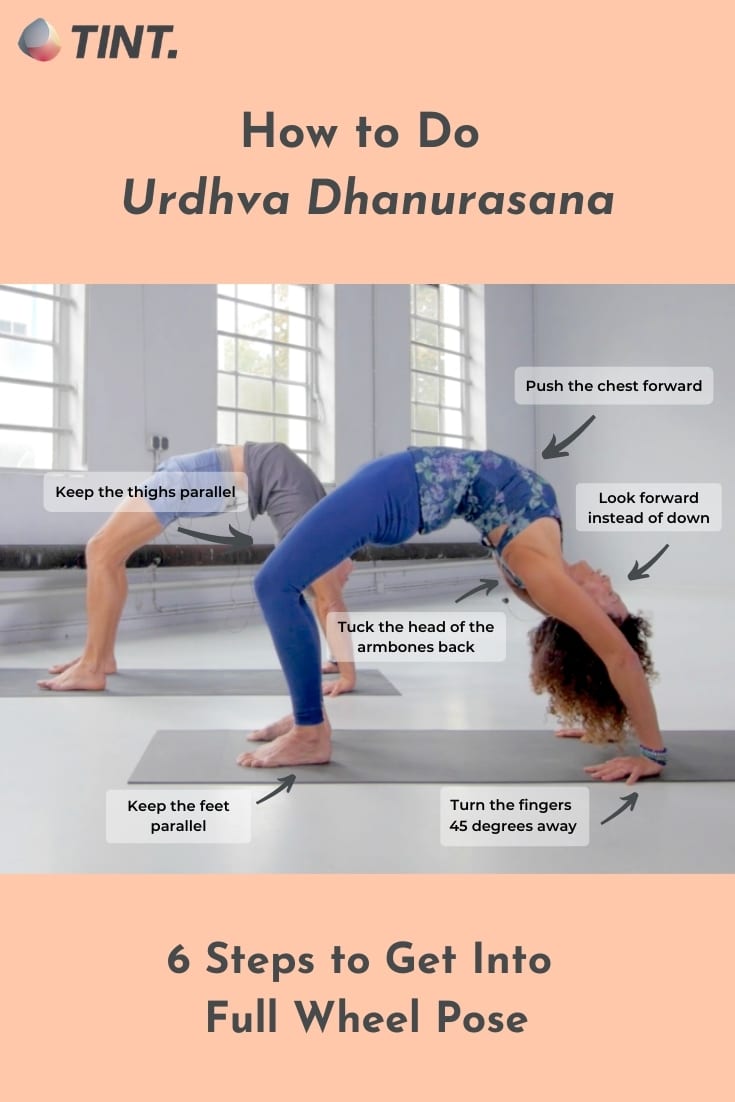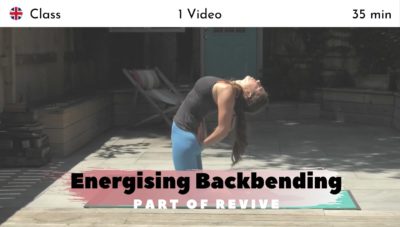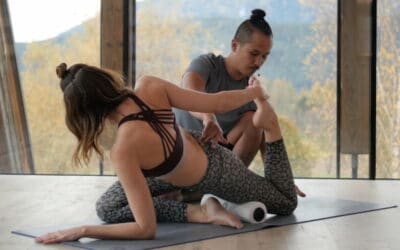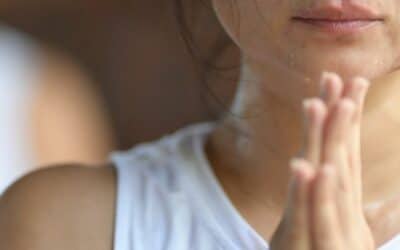Wheel pose, or Urdhva Dhanurasana, can be considered the queen of backbends in yoga. And you certainly don’t approach a queen just like that. You need careful preparation and quite some courage and strength. Always treat this yoga pose with the respect it deserves.
It’s also often called Chakrasana as it’s said to open all the 7 Chakras. The Sanskrit word ‘chakra’ can be translated as ‘wheel’ and refers to the energy centers in the body. As such, it’s a very intense and energising pose – and definitely worth a try!
“Be inspired but not proud.”
Learn how to do Urdhva Dhanurasana:
- 1. How Do You Get Into Urdhva Dhanurasana Step by Step?
- 2. What Is Your Body Doing In Urdhva Dhanurasana (Wheel Pose)?
- 3. How Do You Prepare for Urdhva Dhanurasana?
- 3.1. How to Warm up the Body for Wheel Pose?
- 3.2. How to Do Wheel Pose Gradually?
- 4. Which Wheel Pose Variations Can You Add to Your Yoga Practice?
- 4.1. Wheel Pose for Beginners
- 4.2. Modified Yoga Wheel Pose to Challenge Yourself
- 5. What Are the Benefits of Wheel Pose in Yoga?
1. How Do You Get Into Urdhva Dhanurasana Step by Step?

Learn how to do Urdhva Dhanurasana with Desirée Rumbaugh and Andrew Rivin in their Transformational Home Practice.
- Lie on your back with the feet on the ground parallel to each other.
- Try to reach your heels with the fingers to check whether they are evenly distanced from the outside edge of the yoga mat.
- Keep your feet and legs parallel. This is essential because as soon as you turn your feet out, your knees become apart and you risk putting too much pressure onto your lower back and sacral area.
- Place the hands by the ears with the palms facing down. Turn the fingers out away from each other so that they’re at a 45-degree angle away from each other.
- Tuck the heads of the arm bones in, i.e. towards the toes.
- Press into the palms to lift yourself up.
- Once in the pose, look straight ahead toward a point in front of you rather than looking down on the floor.
- Press down through the arms as well as through the inside edges of your feet.
- Stretch your heart forward toward the front side of your yoga mat.
- To come out of the pose, tuck in the chin to the chest and carefully roll down vertebra by vertebra.
- Rest on your back to pause for a few breaths. You can even close your eyes to enjoy the energy that flows through you.
Now it’s time for you to practice. Roll out your yoga mat and follow Desirée Rumbaugh and Andrew Rivin‘s instructions on how to do Urdhva Dhanurasana in their workshop Building Blocks for Transformational Home Practice on TINT.
Learn how to do Urdhva Dhanurasana with Desirée Rumbaugh and Andrew Rivin on TINT.
2. What Is Your Body Doing In Urdhva Dhanurasana (Wheel Pose)?
2.1. What Are the Joints Doing?
While the spine is extended, there’s a lot going on in the upper part of the body:
- the scapulae (shoulder blades) are upwardly rotated and elevated and the shoulders are flexed;
- the elbows are extended as are the hands and fingers;
- the forearms are in pronation; and
- there’s dorsiflexion in the wrists.
Further down in the lower body, the hips are extended and adducted while the knees are flexed. The ankles are in plantar flexion.
2.2. Which Muscles Are Engaged?
The spinal extensors contract concentrically to help to maximize the extension of the spine. In the same way, the small muscles in the neck help you lift the head away from the floor.
Let’s have a look at the muscular actions in the upper body:
- the serratus anterior contracts to effect the upward rotation and elevation of the scapula;
- the deltoid and the rotator cuff muscles are responsible for stabilizing and protecting the shoulder joint;
- the biceps brachii and the anterior deltoid flex the shoulder;
- the triceps brachii extend the elbow;
- pronator quadratus and teres pronate the forearm; and
- the intrinsic muscles of the wrist and hand help to stabilize the hand.
Moving down to the lower body, we see the following muscular actions:
- the hamstrings and the gluteus maximus contract to effect the hip extension;
- adductor magnus and gracilis are responsible for extending, adducting and internally rotating the hip; and
- articularis genu and vastii extend the knee.
2.3. What Do You Need to Pay Attention to?
For getting into Urdhva Dhanurasana, the correct leg action is crucial. Using the quadriceps muscles in order to extend the knees pushes the bodyweight toward the head and arms. This makes it harder to lift the upper body off the floor. If, on the other hand, more attention is paid to extending the hips in order to lift the body, more weight is distributed over the legs, putting less stress on the upper body.
The adductor magnus muscle is king for this action in Urdhva Dhanurasana because it can effect all the muscular actions required to maintain the proper alignment of the pose: hip extension, internal rotation, and adduction.
Using the gluteus maximus for hip extension instead may even lead to compression and pain in the lower back because it creates an external rotation in the hip.
In order for the arms to move freely overhead, it is required to mobilize the shoulder blades while, at the same time, stabilizing the shoulder joints in their rotations. Here, the rotator cuff muscles are the main player to create the necessary balance.
Short latissimus dorsi muscles can restrict the upward rotation of the scapulae and put an extra amount of stress on the spine and shoulder joints and may even cause shoulder impingement.
Understanding the actions the joints and muscles perform in a certain yoga pose, such as Urdhva Dhanurasana, is essential to understanding proper alignment in your yoga practice. That’s why we created a free yoga asana ebook for you, which summarizes the most important alignment cues for 10 of the most common yoga poses so you can use it as a reference guide in your yoga practice.
3. How Do You Prepare for Urdhva Dhanurasana?
3.1. How to Warm up the Body for Wheel Pose?
Since the Full Wheel pose in yoga is a quite deep backbend, it’s a good idea to warm up the body first. The most important parts of the body you need to prepare for Urdhva Dhanurasana are the quadriceps and the hip flexors.
You can do that, for example, with a few rounds of Sun Salutations or some quad stretches in Low Lunge. Another great stretch for your thighs is Hero Pose (Virasana) or – to make it even more intense – Supine Hero pose (Supta Virasana).
The spine is best warmed up with progressively more intense backbends such as Cobra pose (Bhujangasana), Camel (Ustrasana) or Wild Thing (Camatkarasana).
To prepare the upper body for Full Wheel pose, open the shoulders with poses like Cow Face (Gomukhasana) or bringing the arms into an Eagle shape (Garudasana).
Warm up for Urdhva Dhanurasana with a few rounds of Sun Salutations, e.g. with David Lurey and Mirjam Wagner.
3.2. How to Do Wheel Pose Gradually?
Once the body is warmed up, don’t go straight into the Full Wheel pose, but rather approach it in three stages. Try these three steps suggested by TINT instructors Desirée Rumbaugh and Andrew Riving in their Workshop Strong and Mindful Yoga.
- Stage 1
Place the arms by your sides and bend the arms at a 90-degree angle so that the fingertips point up. Tip your pelvis slightly forward to create an arch in the lower back. Now, push the elbows into the ground to lift your heart even more. Don’t let the ribs pop up too much. Instead, pull the ribs down into the core.
This is a perfect stage 1, you don’t have to get any further than this because you already have a beautiful extension of the spine, working to articulate each one of the vertebrae all through the spine. - Stage 2
If you want to go further, lift the hips while keeping the feet and legs parallel to come into Bridge pose (Setu Bandha Sarvangasana). Check again with the fingertips on the heels that the feet are still parallel. Stay here for a few breaths before you lower down the hips. - Stage 3
Staying in a supine position, place the hands by the ears. Press into the hands to lift yourself up, but don’t come to the Full Wheel pose yet. Instead, only place the crown of the head on the floor and stay here. Pay attention that your feet and the thighs remain parallel.
Although Urdhva Dhanurasana, or Wheel, may be a challenging yoga pose at first, it will become accessible once you’ve understood what to pay attention to when it comes to your alignment. This is why understanding the core principles of correct yoga alignment is the key to mastering all kinds of asanas. To help you with this and other yoga poses, we have created a free yoga asana ebook that you can download for free and use as a reference guide for your yoga practice.
4. Which Wheel Pose Variations Can You Add to Your Yoga Practice?
4.1. Wheel Pose for Beginners
If you feel you’re not quite ready for the Full Wheel pose yet, there are a few modifications and props you can use to make Urdhva Dhanurasana accessible to beginners.
Use a Strap Around the Thighs
The tendency in this yoga pose is that the knees and feet turn out when you lift your body up. As mentioned before, this may cause compression in the lower back. To prevent this from happening, put a strap around your thighs just above the knees. This helps to hold the thighs hip-width apart and parallel to each other.
Use A Strap Around the Upper Arms
Just like your thighs, your arms also have a tendency to drift apart in Urdhva Dhanurasana. Put a strap around your upper arms to avoid this. The loop in the strap should be about the width of your shoulders. Sling this around your arms just above the elbows before lifting into the pose.
Place a Block Between the Feet
It’s also essential to keep the feet parallel. In order to avoid the feet turning out once you’re in the pose, you can place a block between them. Place the bases of the big toes next to the ends of the block. As you lift yourself up, press the feet into the block.
Use Block Against a Wall
One issue that often restricts the full movement into Urdhva Dhanurasana is that the armpits or groins are tight. To increase your range of motion, you can place yoga blocks under either your hands or your feet. Place the blocks against a wall and place each hand or foot on one block. Then, push yourself up into the full pose.
Take Your Hands Wider
You may also have the impression that you have limited range of motion in the shoulders due to tight shoulders. In that case, experiment with taking the hands slightly wider than the shoulders. This will give you some extra space and enable you to straighten the arms when you push yourself up into Full Wheel.
Let a Partner Help You
Set yourself up on the floor in a supine position. Get a partner to stand behind your head facing you and with the feet almost under your shoulders. Instead of pushing your hands into the floor to push yourself up, grab your partner’s ankles.

Full Wheel pose is often referred to as the queen of backbends. Photo: TINT instructor Barbra Noh by Christian Krinninger.
4.2. Modified Yoga Wheel Pose to Challenge Yourself
If you’ve already incorporated Full Wheel pose into your yoga practice for a while, you can spice up your yoga practice with some Wheel pose variations.
Lift One Leg Up
You can, for example, shift your body weight onto the left foot and lift the right foot off the floor. Even try to extend the right leg at about a 45-degree angle to the floor. Hold for a few breaths and place the foot back down on the floor. Then, repeat with the left leg.
Deepen the Backbend
To deepen the pose, lift both heels away from the ground. Push the tailbone toward the ceiling once you’re in Full Wheel. As a next step, walk the feet closer to the hands. This increases the depth of the backbend.

Come on your toes to deepen Wheel yoga pose. Photograph: TINT instructors Desirée Rumbaugh and Andrew Rivin.
5. What Are the Benefits of Wheel Pose in Yoga?
The Wheel yoga pose is a quite intense and energetic pose that is said to increase energy levels by stimulating the thyroid and pituitary glands.
Apart from that, it strengthens not only the arms, shoulders, and wrists but also the legs, buttocks, and abdomen as well as the entire spine.
Urdhva Dhanurasana also improves spinal mobility and stretches and opens the chest and the hips. Like all backbends, it counterbalances all the slouching and sitting with poor posture that are so common in our modern life.
However, Wheel pose – or Chakrasana – doesn’t only have a lot of benefits but also contraindications. It should not be practiced in case of injury or chronic problems with the knees, shoulders, or neck. In case of back injury or carpal tunnel syndrome, you should also refrain from practicing full Wheel pose in yoga.
It’s also not recommended for practitioners suffering from heart problems, headache or migraine, or high or low blood pressure.
Whether you have any of the conditions mentioned above or not, never force your body into the pose before it’s flexible enough to do it without straining. Only go as far as feels safe for you. Always carefully prepare your body for backends and, with constant practice, you’ll become stronger and stronger and more and more flexible to finally achieve Urdhva Dhanurasana or Chakrasana.
Start Practicing Wheel Pose on TINT
You can start practicing immediately on TINT with Desiree Rumbaugh and Andrew Rivin’s Cow Spine practice where you learn the basics of the backbend shape and how to become more flexible and strong in this direction. They also provide more advanced Backbends for Home Practice. Also check out Sianna Sherman’s Fearless Heart Activation or Kat Fowler’s Energising Backbending practice. If you want to give credit to the pose’s name – Chakrasana – open your Heart Chakra to cultivate the energy of the Air element with Cristi Christensen’s Air Vinyasa practice.




Practice the yoga pose Wheel (Urdhva Dhanurasana) with our great instructors on TINT.
Are you ready to approach the queen of backbends now?
Get ready to practice backbends, for example with Sianna Sherman in her energizing vinyasa practice Fearless Heart Activation.
Header picture by Robert Sturman








